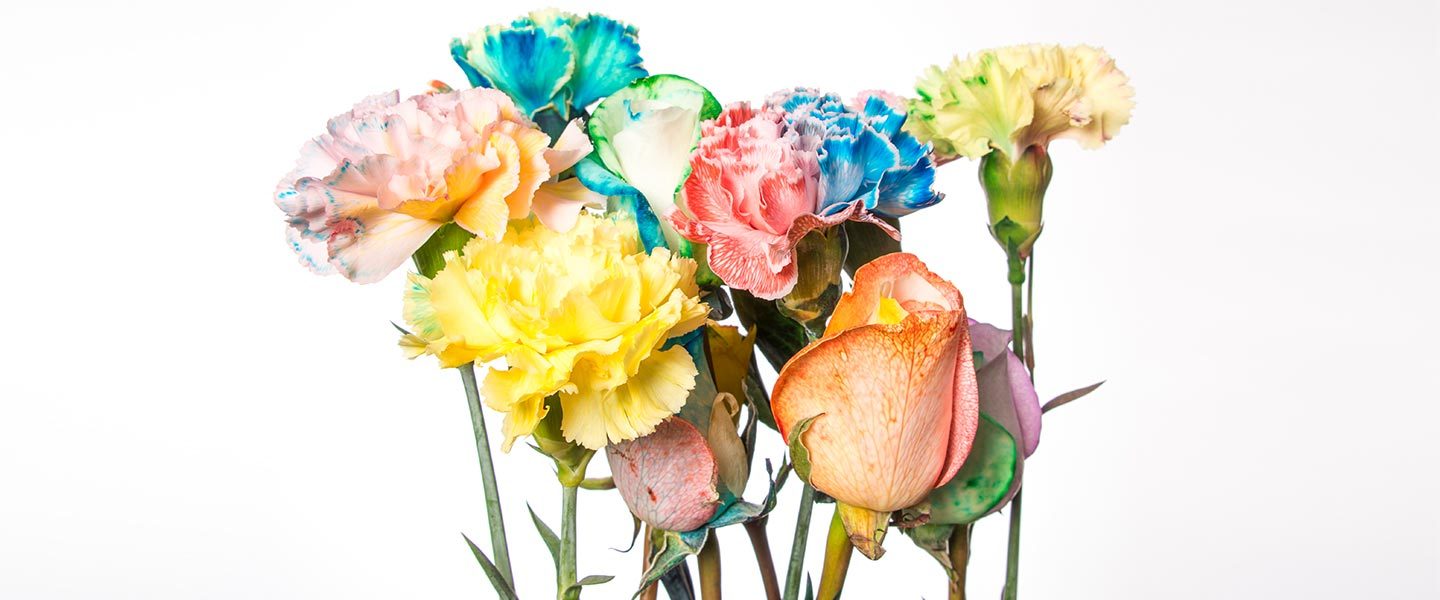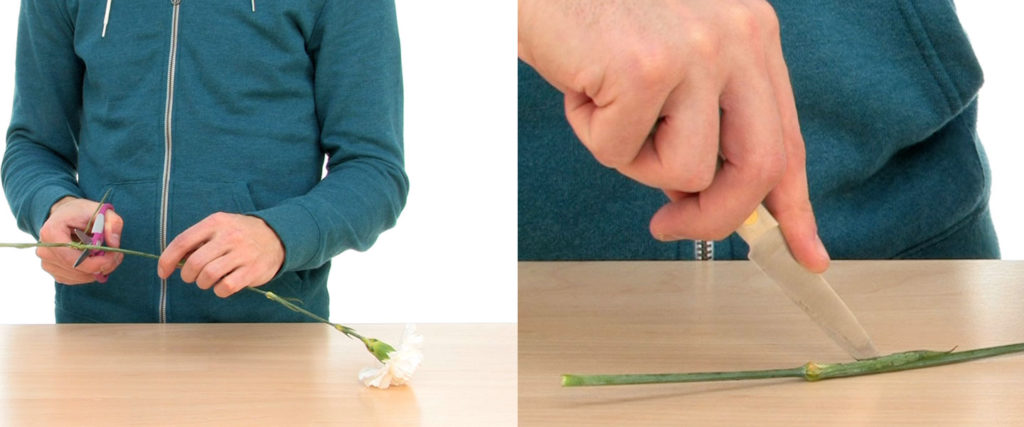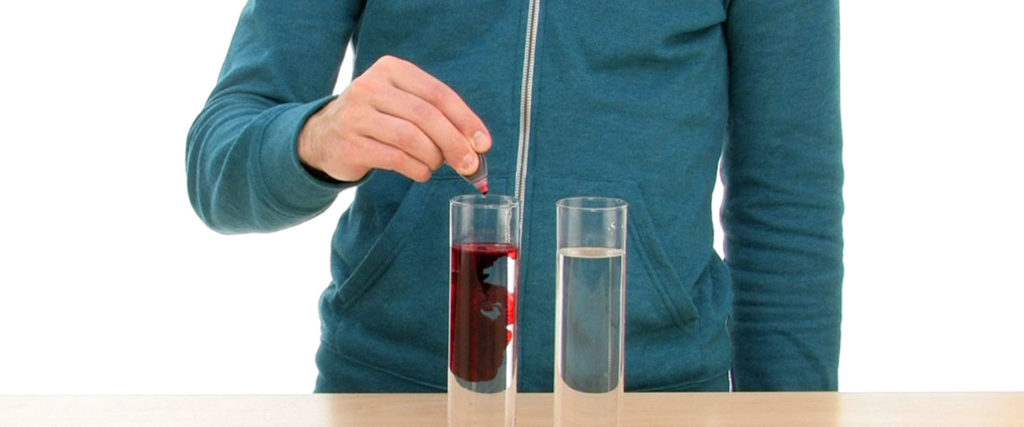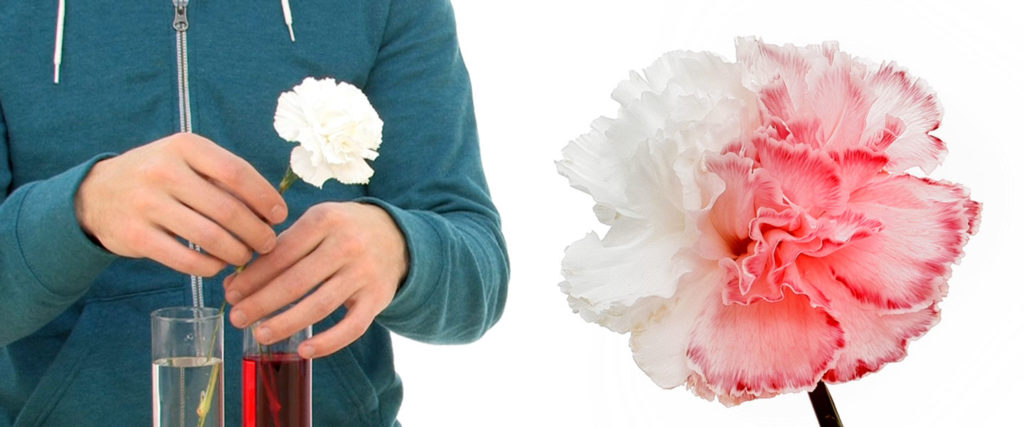The Science of Keeping Flowers Fresh
Drop in a penny… spritz with a sugary soda… stir in vinegar… or give the flowers an Aspirin (which might be needed after all of […]

With this experiment, you can discover for yourself how essential the functions of stems are to plant growth. As the colored water is absorbed, you will be able to see how it moves into the flower and will be amazed when the petals of a white carnation change color.

Before placing any of the flowers in water, have an adult trim about 4” (10 cm) off of each stem. Use a knife and cut at an angle. Keep all the flower stems in plain water for now. (Many gardeners and florists even cut stems under water so no air bubbles can get in to break the tube of water and cause wilting. It’s important that the stem tubes always be filled with water. If air gets into the tube, water may not be able to move up the stem to the flower.)
Have an adult use a sharp knife to slit the stems of three of the flowers straight down the middle. Keep them in the plain water for now.

Fill five of the cups with different colors of water. Fill the other two with uncolored water.

This step is often called “Split Ends.” Place each half of a stem into a cup of different colored water. For example, position the red and blue cups next to each other and put a stem half into each color. Use a color with one of the cups of uncolored water, too. Make a few predictions: Which color will be soaked up? Will the colors mix to make a new color in the petals or will the color in the flower be divided in half?
Place the last white carnation into the remaining cup of uncolored water. This one is your control flower. Let all the flowers sit and soak for several days. As you wait to see the results, make some more predictions: How will the carnation in the plain water compare to the carnations in the colored water? Which color will be soaked up first? How long will it take? Which color will create the darkest shade in a flower? Which color will create the lightest shade in a flower? Which color might not be absorbed?
Most plants “drink” water from the ground through their roots. The water travels up the stem of the plant into the leaves and flowers where it makes food and helps keep the plant rigid. When a flower is cut off the plant, it no longer has its roots but the stem of the flower still “drinks” up the water and provides it to the leaves and flowers. How does this happen?
There are two things that combine to move water through plants — transpiration and cohesion. Water evaporating from the leaves, buds, and petals (transpiration) pulls water up the stem of the plant. This works sort of like you sucking on a straw. Water that evaporates from the leaves “pulls up” other water molecules behind it to fill the space it left. Instead of a mouth providing the suction, it is due to the evaporating water. This can happen because water sticks to itself (cohesion) and because the tubes in the plant stem are very tiny. This water movement process through tiny tubes is called capillary action. Coloring the water with food coloring does not harm the plant but it allows you to see the movement of water into the flower. Splitting the stem simply proves that the tiny tubes in the stem run all the way through the stem from the water to the petals of the flowers. Our unofficial tests indicated that the blue food color went up the carnations the fastest, followed by the red and then the green food colors.
Color Changing Carnations is a good science fair project because you start with a control or something that doesn’t change in the experiment. In this case, the control is the carnation in the plain water. You then test a variable or change one thing in the experiment. Here you change the color of the liquid and then make comparisons between the control flower and the flower that has been exposed to the variable. You think of another idea to test, like splitting the stem in half and testing one or two colors at once, and you make some more comparisons. So, if you wanted to make Color Changing Carnations your own science fair project, what other questions could you ask? These suggestions may give you some ideas.
There are all kinds of questions about carnations that you could explore for a science fair project. Just remember to change and test only one variable at a time. Compare the effect of that variable to the control flower, document your discoveries, and come to some conclusions about plants and how they absorb liquids. Prepare your presentation and get ready to share your research with everyone who attends the science fair.